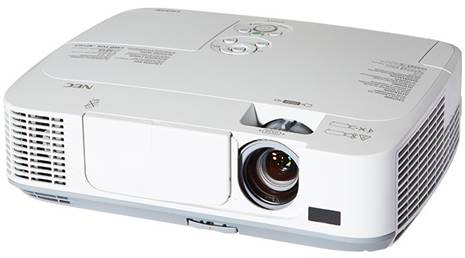The best XGA projectors for the
office and classroom that don’t cost the earth.
Features and Design
Canon LV – 7392A
Like all Canon LV projectors before it,
setting up the LV-7392A proved to be a very quick affair: it was able to
identify the input signal and adjust the image parameters automatically. And
when it was tilted, an auto vertical keystone correction function (works for
±20°) kicked in to fi x the distorted image. The projector also powered up
quickly, and for a quick shut down, all we had to do was to yank the power
cord. The supplied remote is useful for changing the input source and operating
the digital zoom (0.5-4x), but we don’t like its small buttons. Round the back,
there is the usual fare of terminals, such as VGA and composite audio and
video. There’s no separate S-Video or component input, but an S-Video-to-VGA or
a component-to-VGA cable works just fi ne. The LV-7392A does sport an HDMI
input, a microphone input, and network connectivity is supported via a wired
LAN.

The
LV-7392A does sport an HDMI input, a microphone input, and network connectivity
is supported via a wired LAN.
·
Brightness 3,000 lumens
·
Contrast ratio 2,000:1
·
Zoom ratio 1.2x
·
Lamp life 4,000 hours
·
Price $1,199
Epson EB – x15
At 2.3kg, the EB-X15 is the most portable
projector of the bunch. To get the image front and center when placed at an
angle, we simply allowed the automatic vertical keystone correction to work its
magic. For horizontal correction, there’s a handy slider control just behind
the zoom lever. We also like the Quick Corner function, which lets us use the
remote to move any of the four corners of an image to get a rectangular
picture. The EB-X15 has video inputs for HDMI, S-Video, composite, and VGA
(two). There’s also an RS-232C control terminal and a USB 2.0 (Type B) port.
The latter can be used in lieu of a VGA cable for image projection. Sound and
mouse operation can also be routed through this USB cable. Sadly, the EB-X15
falls short by not supporting any form of network connectivity - whether wired
or wireless.

At
2.3kg, the EB-X15 is the most portable projector of the bunch.
·
Brightness 3,000 lumens
·
Contrast ratio 3,000:1
·
Zoom ratio 1.2x
·
Lamp life 4,000 hours
·
Price $1,199
NEC M311XG
Using the M311XG is largely a fuss-free affair
thanks to several thoughtful features. For example, the projector can turn
itself on when a power cord is attached, or when a PC signal is detected. Also,
the sliding lens door disables video and audio when it’s closed. You can enable
Eco mode throughout, or rely on the Auto Eco mode to automatically adjust the
brightness based on the projected image. The M311XG has connectivity options
aplenty: HDMI, VGA (there are a pair), S-Video, composite, wired LAN, RS-232C –
you name it. For wireless, you need a separately sold USB dongle. There are
also two USB ports that serve entirely different functions. One is for reading
JPEG fi les on a fl ash drive, so that you can do PC-less presentations, and
the other lets you project images via a USB cable instead of a VGA cable. If
you’ve an iOS device, you can also use the free Wireless Image Utility app to
project stored images and documents.

Using
the M311XG is largely a fuss-free affair thanks to several thoughtful features.
·
Brightness
·
3,100 lumens
·
Contrast ratio 3,000:1
·
Zoom ratio 1.7x
·
Lamp life 5,000 hours
·
Price $1,299
Sony VPL – EX245
While the VPL-EX245 doesn’t have a lens
cover to disable the projection when you close it, it does have a ‘Pic Muting’
button on the supplied remote that basically does the same thing. Besides
automatically adjusting the brightness based on the projected image, the lamp
will also dim itself after 10 seconds when it senses that the signal isn’t
changing to lower energy consumption. The VPL-EX245 sports a variety of
interfaces, including HDMI, VGA (you get two), S-Video, Ethernet, RS–232C, and
USB (both Type A and B). If you want to be heard at the end of the room, it
also has a microphone input. But what really impresses us is its flexibility
over the network. For example, web control and network presentation are
available to any PC on the same network. For network presentations, up to four
PCs can project images simultaneously to the projector. This is true even when
the projector is connected wirelessly (an optional dongle is needed).

The
VPL-EX245 sports a variety of interfaces, including HDMI, VGA (you get two),
S-Video, Ethernet, RS–232C, and USB (both Type A and B).
·
Brightness 3,200 lumens
·
Contrast ratio 3,000:1
·
Zoom ratio 1.6x
·
Lamp life 3,000 hours
·
Price $1,190